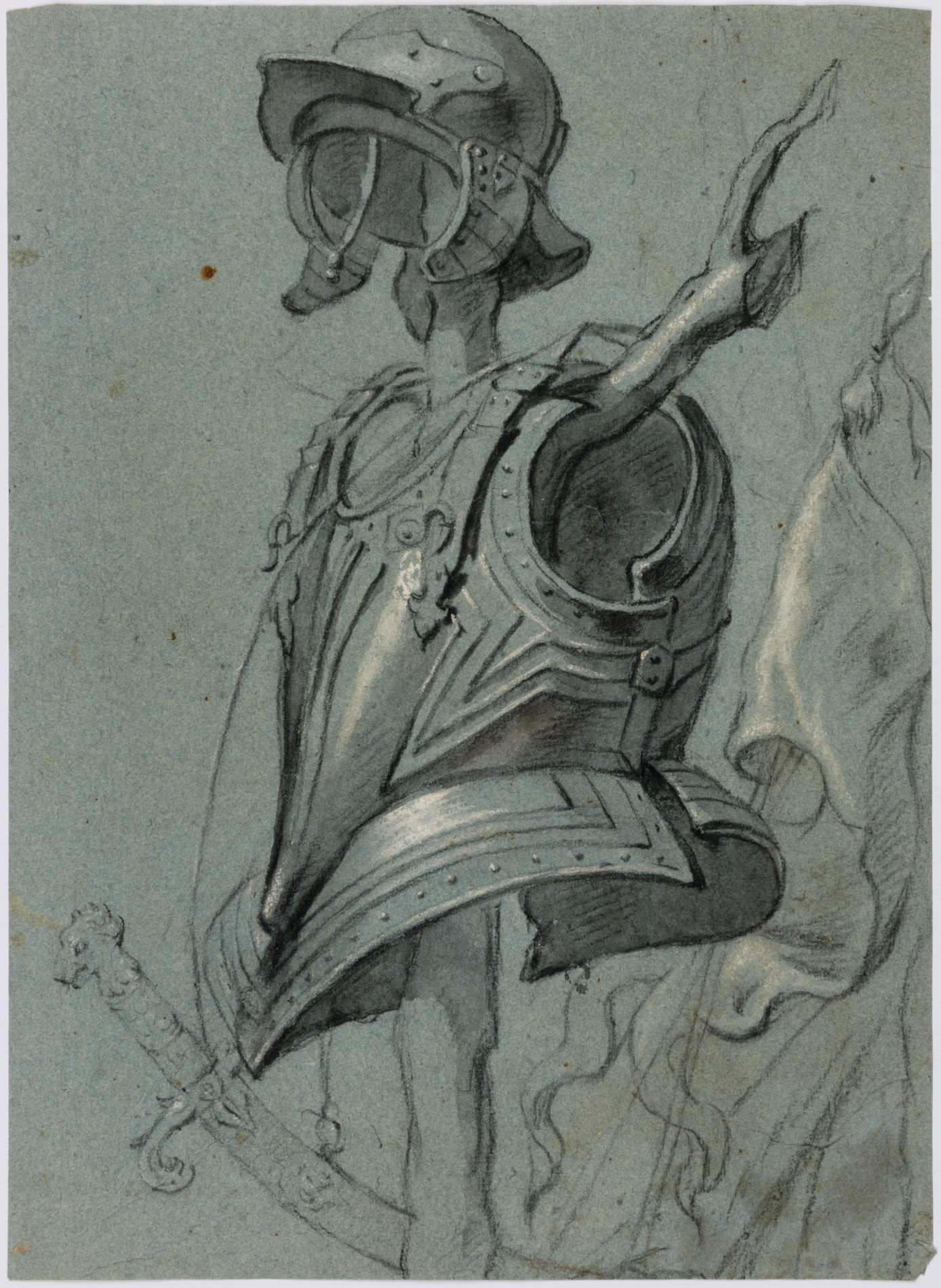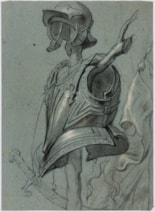Erasmus QUELLINUS
(Antwerp 1607 - Antwerp 1678)
A Trophy of Armour on a Tree Branch
Black chalk and grey wash, heightened with white, on blue paper.
389 x 285 mm. (15 1/4 x 11 1/4 in.)
389 x 285 mm. (15 1/4 x 11 1/4 in.)
The present sheet is attributed to Erasmus Quellinus the Younger. Chalk drawings by the artist are relatively rare, but the present sheet may be likened to two drawings in black chalk on blue paper by or attributed to the artist: a study of The Madonna and Child in the collection of the Harvard Art Museum and a Ceiling Design with Putti which recently appeared at auction. Similar military trophies are found in a very large signed drawing by Quellinus of a design for a triumphal arch, datable to c.1657, in the Hermitage in St. Petersburg, which was a project for a temporary façade for a building on the processional route of Don Juan of Austria, the new governor of the Spanish Netherlands, on his ceremonial entry into Antwerp on 6 May 1657.
Comparable trophies are also found atop a colonnade in the background of a small panel painting of Cybele (Rhea) by Quellinus, signed and dated 1663, in a Belgian private collection. The painting later served as a design for the frontispiece, engraved by Richard Collin, of Engelbert Flacchio’s 'Genealogie de la très-illustré, très-ancienne et autrefois souveraine maison de La Tour, où quantité d’autres familles trouveront leur extraction et parentage', devoted to the history of the Thurn und Taxis family and published in 1709.
In the context of military trophies like that depicted on the present sheet, it is also interesting to note that Quellinus assisted Rubens in making painted copies after some of Andrea Mantegna’s Triumph of Caesar paintings, now at Hampton Court, in which similar motifs appear.
Comparable trophies are also found atop a colonnade in the background of a small panel painting of Cybele (Rhea) by Quellinus, signed and dated 1663, in a Belgian private collection. The painting later served as a design for the frontispiece, engraved by Richard Collin, of Engelbert Flacchio’s 'Genealogie de la très-illustré, très-ancienne et autrefois souveraine maison de La Tour, où quantité d’autres familles trouveront leur extraction et parentage', devoted to the history of the Thurn und Taxis family and published in 1709.
In the context of military trophies like that depicted on the present sheet, it is also interesting to note that Quellinus assisted Rubens in making painted copies after some of Andrea Mantegna’s Triumph of Caesar paintings, now at Hampton Court, in which similar motifs appear.
The son of a Flemish sculptor of the same name, Erasmus Quellinus the Younger probably trained initially with his father before entering the studio of Peter Paul Rubens. His earliest known work is a painting of The Adoration of the Shepherds of 1632, the same year that he joined the painter’s guild in Antwerp, where he was to work for almost the entirety of his career. Throughout the second half of the 1630s Quellinus was active as one of Rubens’ closest collaborators. He worked with the master in the last years of his life; on the decorations for the entry of the new governor Cardinal-Infante Ferdinand into Antwerp in 1635 and, for Philip IV of Spain, on a series of paintings for the hunting lodge of the Torre de la Parada near Madrid, executed between 1636 and 1638. Quellinus also provided title pages and book illustrations for the Plantin-Moretus print workshop and publishers in Antwerp, working under Rubens’ supervision but in his own style. Following the death of Rubens in 1640, Quellinus continued to work as a draughtsman and designer for the Plantin-Moretus firm, and was also appointed the official painter of the city of Antwerp, with responsibility for all civic decorative schemes over the next quarter of a century.
Quellinus enjoyed a reputation as one of the leading ecclesiastical and history painters in Flanders, and also produced a number of portraits. Among his largest works are two paintings commissioned by Jesuits, an Immaculate Conception for the church of Saint-Michael in Louvain and an altarpiece of Saint Gregory of Nazianzus now in the cathedral of Lima in Peru. In 1656 Quellinus and his younger brother Artus, a sculptor, were invited to Amsterdam to contribute to the decoration of the new City Hall. Apart from Rubens, Quellinus painted easel pictures in collaboration with such artists as Pieter Boel, Daniel Seghers, Jan Philip van Thielen, Jan Fyt, Joris van Son and Jan Pieter Brueghel, while among his pupils were his son Jan-Erasmus Quellinus and Wallerant Vaillant. Quellinus died in Antwerp in November 1678, at the age of seventy-one.
Extant drawings by Erasmus Quellinus the Younger – several of which are signed although none are dated - include studies for paintings and altarpieces, as well as designs for frontispieces, book illustrations and engravings. Signed drawings by the artist can be found in several museum collections, including the Koninklijk Museum voor Schone Kunsten and the Museum Plantin-Moretus in Antwerp, the Kupferstichkabinett in Berlin, the Musées Royaux des Beaux-Arts in Brussels, the British Museum in London, the State Hermitage Museum in St. Petersburg, the Nationalmuseum in Stockholm and the Royal Library at Windsor Castle.
Provenance
An unidentified collector’s mark Hugo (Lugt 4609), with associated number No 61, stamped on the verso
Galerie Paul Prouté, Paris in c.1976
Paul Mathias Polakovits, New York and Paris (Lugt 3561), by 1984
Thence by descent.
Galerie Paul Prouté, Paris in c.1976
Paul Mathias Polakovits, New York and Paris (Lugt 3561), by 1984
Thence by descent.
Literature
Michael Jaffé, ‘Jordaens Drawings. By R. A. d’Hulst. Jacob Jordaens. By R. A. d’Hulst.’ [book reviews], The Burlington Magazine, December 1984, p.784, note 3, fig.56 (as Jacob Jordaens).




